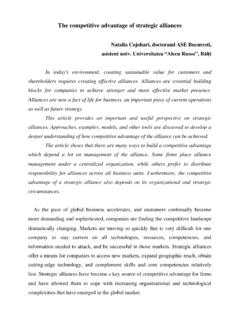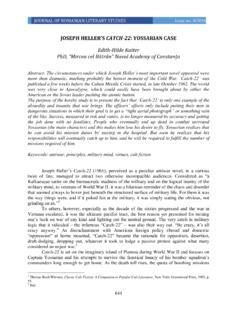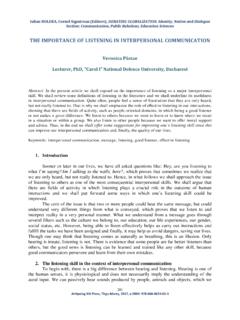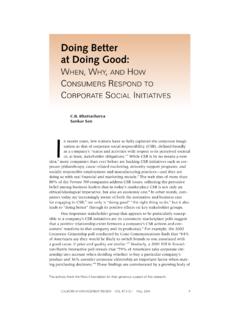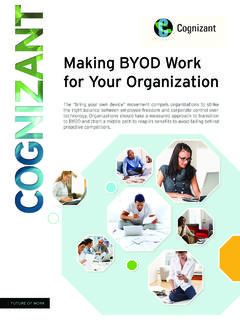Transcription of A POSSIBLE MODEL FOR MEASURING THE SERVICES QUALITY …
1 CCI3 ECONOMY AND MANAGEMENT. A POSSIBLE MODEL FOR MEASURING THE SERVICES QUALITY IN. hospitality branch . Doriana Dumitrela Morar, PhD. Student, Ioan Pl ia , Prof., PhD, Babe -Bolyai . University of Cluj-Napoca Abstract: Based on a better forecasting and response to customers' needs, the companies compete with each in order to provide superior value. Recognizing customers as seekers for solutions for their problems and for values that result from the use of what they buy, it is fundamental for the long-term business viability. The way in which a company defines its business, and the way in which it desires to build its market image, depends on the understanding of this issue.
2 This article explores new directions regarding service QUALITY and also the determining dimensions of QUALITY as expected by the consumers. Furthermore, in the present paper, the authors emphasize the differences existent between the degrees of importance that various dimensions have in defining service QUALITY . The objective of this paper is to evaluate in a critical manner the different models used for MEASURING service QUALITY and, based on the traditional models; the authors will elaborate a new conceptual MODEL for MEASURING service QUALITY in the hospitality industry.
3 Keywords : value, customer satisfaction, MODEL of measurement, service QUALITY , hospitality industry. Introduction In the last decades, the service industry has become the dominant sector of the economy, and relevant studies show that the service QUALITY variable is an essential condition to the success and survival of the firms in today s competitive environment. Therefore, the interest in service QUALITY has increased in a visible manner (Ghobadian et al, 1994 cited in Akbaba, A, 2005). According to relevant literature, service QUALITY leads to loyalty, attracting new customers, positive word-of-mouth, employees satisfaction and implicitly their commitment, improved corporate image, cost reduction and increase in business performance.
4 (Berry et al., 1989). And while the service industry and the QUALITY variable as a competitive advantage are considered to become more important than ever, the service QUALITY concept has yet to be fully developed, even though Ghobadian et al. first underlined this fact in 1994. The process of evaluating service QUALITY is far more complex than that of evaluating product QUALITY . This is the result of the service inner nature, its heterogeneity, the fact that its production cannot be separated by its consumption, as well as its perishability and intangibility (Frochot and Hughes, 2000).
5 In the hotel industry, other attributes, which make difficult evaluating service QUALITY , have been identified, such as imprecise standards, short distribution channels, reliability and coherence, interactions and information exchanges with 12. CCI3 ECONOMY AND MANAGEMENT. customers, and fluctuating demand. All these complicate even more the task of defining how service QUALITY should be delivered and measured in the hospitality industry. Furthermore, the demand for hotel SERVICES is generally grouped around peak periods of the day, week or year, which further increases the difficulty of delivering SERVICES of higher QUALITY (Barrington and Olsen, 1987; Mei et al.)
6 , 1999). As our endeavor is to create a better MODEL for MEASURING service QUALITY , we have undertaken a vast literature review, by analyzing some of the existing models in relevant literature. Based on our finds, we will try to elaborate a MODEL for MEASURING service QUALITY adapted to the hospitality hotel industry. 1. Literature review Since 1980, the concept of service QUALITY has been a much discussed and controversial subject, which has yet to receive an universally accepted definition. Authors, such as Christian Gr nroos, Leonard L. Berry, A. Parasuraman and Valarie A.
7 Zeithaml, have had a significant contribution to literature. With the idea that SERVICES are different from products as a starting point, these authors have underlined the need for a better understanding of the concept of service QUALITY . The most relevant articles are from the period between 1985. and 1988, which have greatly increased the theoretical and practical knowledge in the field of service QUALITY . Parasuraman, Zeithaml and Berry (1985, p. 41) highlight the difficulty of defining the concept of service QUALITY since they consider it to be an evasive and unclear term, based on service characteristics of intangibility, heterogeneity and inseparability.
8 Because of service intangibility, it is more difficult for companies to understand how customers perceive and evaluate service QUALITY . In the case when a service is bought, there is less physical evidence than when a product is bought. Because of the lack of concrete evidence, customers need to use other types of clues when deciding if a service offer is superior to another one. Secondly, SERVICES are heterogeneous. This means that the notion of service QUALITY varies depending on the performance of the front-line personnel, the time when it was delivered and the type of client who received it.
9 Taking these characteristics into account, it becomes a difficult task for companies to ensure a high consistency between the service which was offered and the service which was finally delivered. This, in turn, makes troublesome for companies to determine on an objective level the given service QUALITY at a certain point in time. Thirdly, because of the inseparability between production and consumption, service QUALITY is mainly limited to the QUALITY of the interactions between the service supplier and customer. As it follows, the two partners (front-line personnel and customers) can positively or negatively influence the perceived level of service QUALITY .
10 This limits the company in what it can do to control the QUALITY of the SERVICES they provide. Eventually Parasuraman et al. (1985), cited in Gr nroos (1990), highlights the necessity for companies to identify the basic elements which customers use in evaluating service QUALITY . The same idea is presented by the representative of the Nordic School (Gr nroos, 1991, pp. 36-37) when they state: when a service supplier knows the way customers evaluate service QUALITY , it can influence that evaluation in the direction it desires . 13. CCI3 ECONOMY AND MANAGEMENT. In Lewis vision (1989), service QUALITY is a critical dimension of competitiveness.
